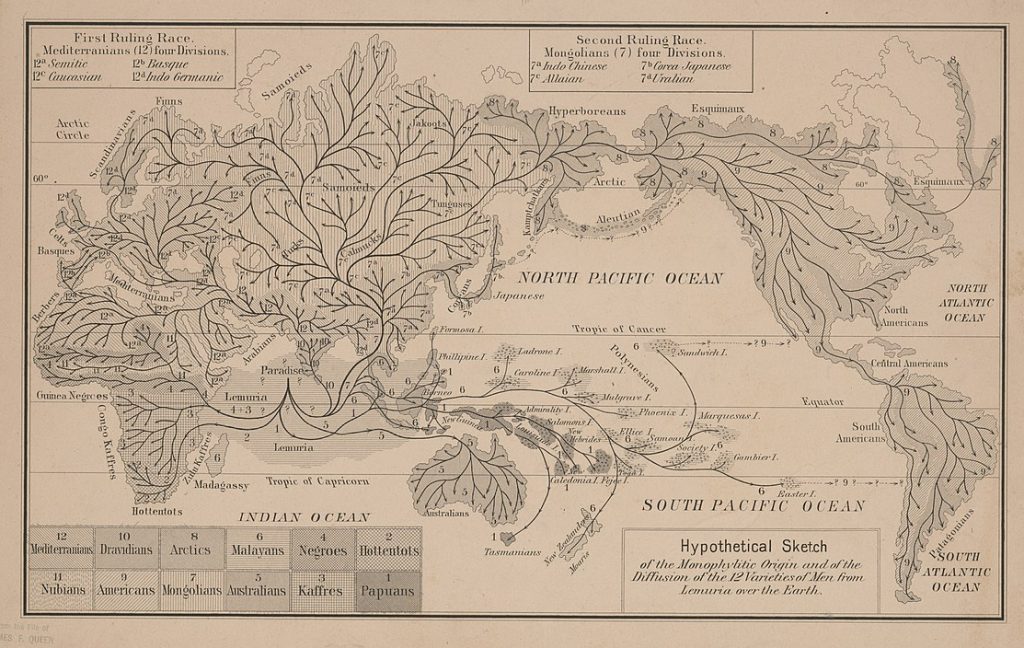This article about Lemuria was posted to alt.archaeology on May 8, 1996. I have edited the original post for spelling, typos, other errors, and conversion to HTML format.
From - Fri May 10 00:04:02 1996 Path: news.intersurf.net!usenet From: Heinrich Newsgroups: alt.archaeology Subject: Re: Lemuria - Here We Go Again Date: Wed, 08 May 1996 21:37:18 -0600 Organization: Myself only
>nalu@lava.net (Antonio Giuseppe) wrote:
LEMURIAN LOST CONTINENT ROCKS FOUND IN HAWAII
By Ed Rampell
Maui Loa, the curator of the Hawaiian Ethnic Art Museum located on Oahu’s fabled Sunset Beach, invites archeologist’s, scholars and the intellectually curious to examine a remarkable collection of lava rock sculptures recently uncovered in the Hawaiian Islands.
…..material omitted…
The museum’s curator, a native Hawaiian, maintains that, “the rock carvings correlate to Polynesian myths of a golden race of people, somehow surviving the cataclysmic disappearance into the sea of the lost continent of Lemuria, the Pacific’s Atlantis”.
……material omitted…….
rock carvings, like stone tablets, represent the prehistoric record of ancient people. In the case of the Polynesian survivors from a lost Lemurian continent, these stone figures might very well be an older civilization’s advanced learning tools.
= Its Back! Or Lemuria Returns to Haunt Its Creators ==
(as abstracted from Lost Continents by Sprague de Camp)
The concept of Lemuria, as a scientific Frankenstein, has resurfaced again to haunt the European scientists who first created it. Unknown to many people, the idea of Lemuria was not created in prehistoric times, but rather by European and American scientists in the late 1800s as a way of explaining the distribution of rocks, fossils, and animals in the days when continents were considered immovable and immutable features of the Earth prior to the development of modern theories of continental drift and sea floor spreading (de Camp 1954).
The Birth of Lemuria
The concept of Lemuria was born in the 1860s and 1870s, when a group of British geologists noted the striking similarity between fossils and sedimentary strata found in India and South Africa. Geologists, e.g. Stow and Blanford in India and Griesbach in Africa, noted that strata of Permian age in India, South Africa, Australia, and South America (245 to 286 million years ago) were almost identical in the types of sedimentary rocks that comprised them. In addition, these strata on these continents contained identical fossils of land plants, e.g. cordaites and “Glossopteris” and land animals, e.g. Therapsids. Because these land plants and animals could not have crossed the open sea and continents were thought to be immobile, geologists explained the presence of identical fossil plants and animals on India, Africa, South America, and Australia by postulating the existence of land bridges and even whole continents that had long since sunk beneath the oceans. In one case, they postulated the existence a large land bridge that once connected India and South Africa. In the “Erdegeschichte” (1887) of Neumayr, this hypothetical land bridge was called “Indo-Madagascan Peninsula” (de Camp 1954).
Ernest Heinrich Haekel, a strong advocate of the evolutionary theory of Darwin, like Thomas Huxley, used the hypothetical land bridge of “Indo-Madagascan Peninsula” in his theorizing. Haekel used it to explain the distribution of lemurs in Africa, India, Madagascar, and Malaya Peninsula. He proposed that this hypothetical land-bridge had stayed above water long enough for it have served as the means by which lemurs spread into these areas. The English biologist, Philip L. Scalter named this land bridge “Lemuria” because of its hypothesized association with lemurs. Thus, Lemuria was neither named nor conceived of by prehistoric people, but by geologists and biologists in the 1800s (de Camp 1954). When plate tectonics and other more prosaic theories better explained the distribution of strata, fossils, and lemurs, it became clear that Lemuria and other such continents and land bridges never really existed, e.g. Wicander and Monroe (1989).
The Reincarnation of Lemuria
Lemuria was reincarnated as a lost continent by Madame Blavatsky, the greatest of the modern occultists. Madame Blavatsky incorporated this concept of Lemuria, in a confused form, together with Atlantis and bizarre mixture of scientific, occult, and Hindu religious material, including the Rig-Veda in her book, The Secret Doctrine. In this book, Lemuria became a lost continent, although still in the Indian Ocean, populated by ape-like hermaphroditic egg-laying creatures. Later writers of occult, lost-continent tales, e.g. Annie Besant, W. Scott-Elliot added their own detail and embellishment to the story of Lemuria, including dinosaurs and 12 to 15-foot bronze humanoids. The final event in the reincarnation of Lemuria occurred when writers of occult books moved the location of Lemuria from the Indian Ocean to the Pacific Ocean (de Camp 1954). Since then, mystics and psychics have written innumerable books about Lemuria and either tuned into the spiritual essence and vibrations or channeled for the spirits of long departed Lemurians who never existed to begin with.
When the theory of continental drift was developed, people realized that it and other more prosaic theories explained the distribution of animals, fossils, and plants better then lost continents. As a result, Lemuria was allowed to fade away into obscurity, while eclipsed by more realistic theories long before there were GEOSAT and SEASAT satellite data to demonstrate the fictional nature of Lemuria.
For the original story read:
de Camp, S. L., 1954, Lost Continents: The Atlantis Theme in History, Science, and Literature. Gnome Press, Inc., New York.
Other references
Wicander, R., and Monroe, J. S., 1989, Historical Geology: Evolution of the Earth and Life Through Time. West Publishing Company, New York.
…..signature of original post omitted….
Version
4.0
Dec 14, 2001
Copyright © 1996-2002 Paul V. Heinrich All rights reserved.
You may also like
-
The Ninety-Foot Plum Tree, Filling Some Gaps
-
The Rise & Fall Of Atlantis And The Mysterious Origins Of Human Civilization (Book Review)
-
Tiwanaku (Tiahuanaco) Site Bibliography
-
An Evaluation of the Geological Evidence Presented By “Gateway to Atlantis” for Terminal Pleistocene Catastrophe
-
Bimini Road

